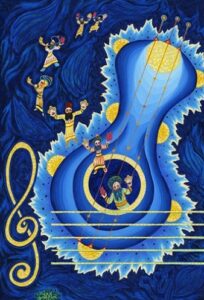בס”ד
By Rabbi Moshe Goodman, Kollel Ohr Shlomo, Hebron

When contemplating this painting with hasidim playing musical instrument in the midst of a water
background, the Song of the Sea found in this parsha comes to mind. There are seven hasidim, the special
Jewish number. The two lowest hasidim are opposites in the sense of where they place the timbrel and the
pomegranates in their hands. Therefore, it seems that these hint to hesed and gevura which are considered
opposites in Kabbalistic reference. Above these there is a hasid holding two timbrels, one in each hand, a
matter that seems to “bridge” the two former hasidim, and “bridging/connecting” is a trait found in the
sefira of Tiferet. Then, above these are two hasidim sounding the shofar, an instrument that resembles the
trumpet, which the Zohar ties to Netzach and Hod. Then, we see two, the smallest of the hasidim, at the
top of the painting. These seem to allude to Yesod and Malchut, since Malchut-kingship is associated with
King David, called the “smallest one,” and Yesod is considered strongly associated/similar to the Malchut.
Also on Kabbalistic reference we find theme of “the line and the sphere” discussed in Kabbalah of the
Arizal in regard to the beginning of the Emanation of all the Worlds. In the center of the “guitar” we find a
hole/sphere within which pass three lines. The Arizal indeed explains that the “line” is actually comprised
of three elements, “right, left, and center.” This “line” passes through an almost full yellow sphere
resembling the sun, a concept associated with “giving” as the sun “gives” light to the moon. Indeed, the
“line” in the Arizal’s teaching represents the “giving” of the spiritual “light” into the “sphere” which
receives this “light.” Surrounding the spherical guitar are seven half-spheres, resembling more the moon
than the sun, since the moon is many times in the shape of various slivers. Thus, these moons and also the
theme of the “sphere” represent “receiving” the light from the “line,” as in feminine receiving from
masculine. Indeed, the number seven is associated with the feminine, while the number three is associated
to the masculine, Kabbalistically [in the model of the first three sefirot and under them the seven sefirot
which receive from them].
In the life of Avraham we find connections between Hebron-Kiryat Arba and Be’er Sheva, both settled by
him. Be’er Sheva at Avraham’s time was considered “land of the Philistines,” along with Gaza. Kiryat
Arba has the number four, which the Kabbalists many times attach actually to three, since these three refer
to Hochma, Bina, and Da’at, and Da’at is actually comprised of two elements [“right and left” aspects] that
are adjoined as one. This is why the tefilin has a three-pronged shin on one side, and a four-pronged shin
on the other. Hebron itself means unity, a concept strongly associated with the number three, which
represents the unification of two opposing points. Be’er Sheva, on the other hand, represents the number
seven, as apparent from its name. Thus, this connection that Avraham formed between Hebron and Be’er
Sheva seems to hint to the connection between the number three, I.e the masculine, and the number seven,
I.e the feminine, thereby bringing blessing to the world through their unification.



